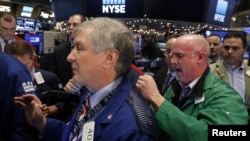The S&P 500, Dow Jones Industrial Average and NASDAQ Composite all touched record highs to start off 2017, with the Dow coming within 0.37 points of the key 20,000 level, and the S&P 500 and NASDAQ closing at all-time highs. The S&P 500 has now gone 59 consecutive days without a 1 percent drop, one of the longest streaks going back 45 years and the longest such streak since 66 in a row during the summer of 2014, according to LPL Financial Jobs Data.
The key monthly Employment Situation Report came mostly in line with expectations and was the last one of President Barack Obama's administration. The American economy added 156,000 jobs in December, while the unemployment rate ticked up to 4.7 percent, according to the Bureau of Labor Statistics. That was up from a post-recession low of 4.6 percent in November. The Labor Department also revised the job gains in November and December upward by 19,000.
Since Obama took office in 2009, the economy has added over 11 million jobs, a tremendous improvement since U.S. unemployment reached a peak of 10 percent in October 2009. In fact, this month marks the 75th consecutive month of job gains in the United States. Average hourly earnings also rose 0.4 percent in December, bringing the 12-month increase to 2.9 percent, the best annual performance since the recovery began in mid-2009.
“In the year ahead, then, we can probably expect to see these trends continue,” said Brad McMillan, Chief Investment Officer for Commonwealth Financial Network. “Companies will create jobs, but they will have a tougher and tougher time filling them. They will be forced to raise wages and hire more marginal candidates, expanding the labor force and increasing spendable income. Those people, in turn, will become more confident and go out and spend.”
Trading week ahead
The consumer is in focus next week with reports on December retail sales and consumer, as well as November consumer credit. Several members of the Federal Reserve will be on the speaking circuit, including Chair Janet Yellen on Thursday at a town hall event with educators in Washington, D.C. Even though the headline number of the December jobs report was disappointing, the details were strong and should keep the Fed on track for two to three rate hikes in 2017.
Next catalyst
Outside of President-elect Donald Trump's inauguration, traders will now turn their attention to fourth-quarter earnings and whether the bar has been set too high for the quarter or, more likely, for the 2017 outlook. The large-cap financials including Bank of America, JP Morgan and Wells Fargo kick off earnings Friday morning.
Analysts expect an increase year-over-year, which would be the second consecutive increase in quarterly earnings for the S&P 500 after four quarters of declines that began in the third quarter of 2015.
“As long as investors don't anticipate a greater-than-average beat, fourth-quarter earnings shouldn't rock the market,” Lindsey Bell, investment strategist S&P Capital IQ, said in a research report. But, it could be corporate forward guidance that may be muted.
“Trump's policies remain very uncertain and there are the potential effects of the rising dollar and oil prices that management teams will once again have to contend with in planning the year ahead,” Bell said. “We think corporate guidance will unlikely move higher in the near term and could even be reduced from the current estimate, as is standard practice, disappointing investors and potentially causing a pullback or pause in the market. That's not to say that estimates can't increase as the year unfolds and campaign policies become reality.”







